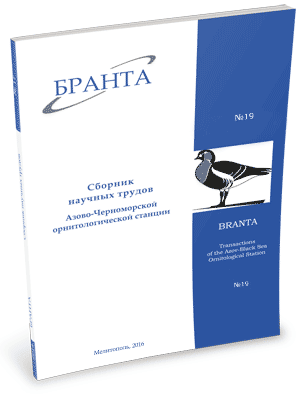
Transactions
of the Azov-Black Sea Ornithological Station



Birds of the artificial forest near Mykhailivka, Saki District (AR of Crimea, Ukraine)
V. M. Kucherenko
The studied artificial forest is located in the western part of the steppe zone of Crimean Peninsula. We found 22 breeding species of birds. The Chaffinch (Fringilla coelebs) and Whitethroat (Sylvia communis) were dominant. Less numerous were the Goldfinch (Carduelis carduelis), Hawfinch (Coccothraustes coccothraustes), and Great Tit (Parus major). We assume that shelterbelts serve as dispersal corridors for most of the species from the mountain forests of the Crimean Peninsula. The Hawfinch is the exception and probably able to settle in the forests isolated from its main habitat. The Pheasant (Phasianus colchicus) population is linked with introduction of these birds by hunting farms.
Read the paper in a PDF fileReferences:
- Andryushchenko, Yu. A., & Popenko, V. M. (2008). New data on birds of prey in the Steppe Crimea. In Recent studies on Falconiformes and owls. Proceedings of the third international conference “Birds of Prey in Ukraine” (pp. 19-25), Kryvyi Rih, Ukraine. [in Russian].
- Averin, Yu. V. (1953). Harmful and useful vertebrates of tree-bush plantations of the Steppe Crimea. Transactions of the Crimean branch of the Academy of Sciences of the USSR, 3 (2), 6-35. [in Russian].
- Averin, Yu. V. (1955). Agricultural value of some birds of the steppe Crimea Transactions of the Crimean branch of the Academy of Sciences of the USSR, 9, 111-131. [in Russian].
- Gavris, G. G. (2002). Additions to the avifauna of the steppe Crimea by the example of the Saki city park. Branta: Transactions of the Azov-Black Sea Ornithological Station, 5, 134-138. [in Russian].
- Kostin, Yu. V. (1983). Birds of the Crimea. Moscow: Nauka. [in Russian].
- Kuzyakin, A. P. (1962). Zoogeography of the USSR. In Scientific notes of N.K.Krupskaya Moscow Regional Pedagogical Institute. Biogeography (Vol. 109 (1), pp. 3-182). [in Russian].
- Naumov, R. L. (1965). Methods of absolute counts of birds during the breeding season along census routes. Zoological Journal, 44 (1), 81-94.
- Shchegolev, V. I. (1977). Quantitative counts of birds in the forest zone. In Research methods of productivity and structure of bird species within their habitats (pp. 95-102). Vilnius: Mokslas [in Russian].
- Tsvelykh, A. N. (2006). The avifauna elements of the mountainous Crimea in insular planted forests of Kerch Peninsula. Vestnik Zoologii, 40 (3), 241-248. [in Russian].
- Tsvelykh, A. N. (2009). On the distribution of the Nightingale (Luscinia luscinia) on the Crimean Peninsula and adjacent territories. Branta: Transactions of the Azov-Black Sea Ornithological Station, 12, 169-173 [in Russian].
- Tsvelykh, A. N. (2010). Counter extension of ranges of the Thrush Nightingale, Luscinia megarhynhos and the Nightingale, Luscinia luscinia (Aves, Turdidae) on the Crimean Peninsula and adjacent territories. Vestnik Zoologii, 44 (6), 519-523 [in Russian].
- Vetrov, V. V., & Milobog, Yu. V. (2008). Distribution of Imperial Eagle (Aquila heliaca Sav.) in the steppe zone of Ukraine. In Recent studies of Falconiformes and owls. Proceedings of the third international conference “Birds of Prey in Ukraine” (pp. 51-55), Kryvyi Rih, Ukraine. [in Russian].